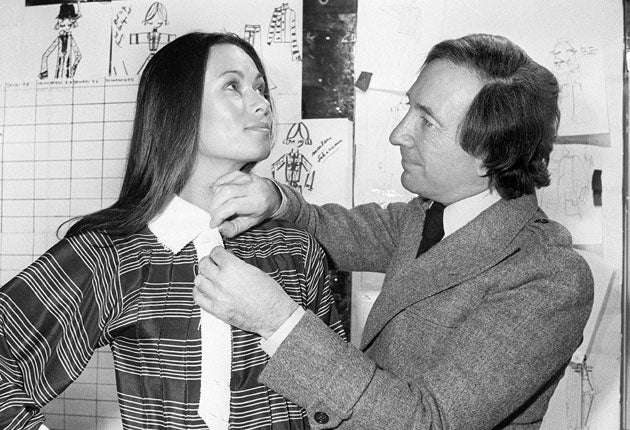Ted Lapidus: Fashion designer who brought haute couture to the high street

There is often a huge discrepancy between the mediacoverage and attendant publicity generated by fashion shows and the visibility of the couturiers' designs on the street. Ted Lapidus aimed to bridge that gap and make haute couture more affordable,believing that, "with the right workforce, there is no reason why a factory-made garment should not be aswell-produced as one coming out of a fashion house."
He put that principle into operation and dressed stars like Françoise Hardy, Brigitte Bardot, Johnny Hallyday and Alain Delon in his trademark safari or "saharienne" suits. He popularised the unisex look through arange of ready-to-wear clothes available in his own boutiques, allowed Lapidus designs to be made and sold under licence in the department store La Belle Jardinière and created the Tex range for the Carrefour supermarket chain.
Lapidus proved influential outside France, too, and was the first designer to persuade Twiggy to wear a suit and tie rather than a mini-skirt. John Lennon was another admirer and in 1969 he asked Lapidus to design a white leather bag to house a set of 14 erotic lithographs he had made. Known as "Bag One", the limited edition of 300 bags incorporated zips, handles and a lock, as well as Lennon's signature in black, and was hand-stitched in Italy and later autographed by the Beatle. An exhibition of the lithographs at the London Art Gallery in January 1970 attracted the attention of the Vice Squad, though their attempt to prosecute Lennon for obscenity failed. "Bag One" originally sold for £550 and has become extremely collectable. In the Seventies, Lapidus diversified into perfumes and accessories; in the Eighties he began attracting outside investors to his company and eventually sold it.
Born Edmond Lapidus in Paris, he was the son of a Russian immigrant tailor. During the Second World War, the family moved south and he was educated at lycées in Marseillesand Annecy. He intended to study medicine in the French capital but switched careers and worked for Pierre Cardin for a few months at the end of the Forties. Lapidus struck out on his own in 1951 though he struggled to make a name for himself as he tried to follow in the footsteps of Cardin and André Courrèges.
He spent some time at the Tokyo Technical School and decided to adapt the manufacturing principles he saw in operation in Japan to the world of fashion. His first collection caused a sensation, with crowds spilling out of the salon on to the pavement, and in 1963 he confirmed his status as one of the stars of the nouvelle vague of French fashion when he became a member of the highly exclusive Chambre Syndicale de la Haute Couture.
In 1957, Lapidus had opened his first boutique in Paris with the financial backing of his friend, the singer Charles Aznavour. By the mid-Seventies he had a chain of over 35 Lapidus stores, including one in London's Bond Street, and had set up a partnership with L'Oréal to launch Parfums Ted Lapidus, one of many successful ventures – which also included pens, sunglasses and watches – which have kept the Lapidus name and brand visible over the years.
Lapidus put a militaristic spin on the unisex look and persuaded men and women to wear what looked like huge army officers' great coats, with shiny gold or brass buttons, piping and épaulettes. His sandy-coloured "saharienne" suits and blazers, meanwhile, freed men and women from the trappings of convention and gave them a certain freedom of movement. For a while, in the late Sixties and early Seventies, at the height of the "Peace and Love" and women's liberation movements, his unisex designs became ubiquitous and inspired dozens of imitations. Lapidus also created uniforms for the Israeli women's army and China Airlines. He brought denim material, traditionally associated with the French working classes, into the world of fashion, and boasted: "My clothes make anyone look 10 pounds slimmer and 10 years younger."
His sister, Rose Torrente-Mett, who is also a fashion designer, felt Lapidus would have been even more successful if he had met someone like Pierre Bergé, whose business acumen proved crucial in the career of Yves Saint Laurent. After selling his business, Lapidus was involved in a dispute with his son Olivier over the rights to use the family name. "Your name is not a name but a brand," Lapidus senior told his son, who resorted to using the names Olivier L, Olivier Verdier, Olivier Robert or Olivier Montagut for his designs. They eventually made up and Olivier ran the company when his father retired to the French Riviera in the mid-Nineties. In his spare time, Lapidus wrote poetry and completed a 700 page-long manuscript he intended to publish, as if to justify his status as "the poet of French couture".
Pierre Perrone
Edmond Lapidus, fashion designer: born Paris 23 June 1929; twice married (three sons, one daughter); died Cannes 29 December 2008.
Join our commenting forum
Join thought-provoking conversations, follow other Independent readers and see their replies
Comments